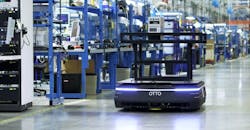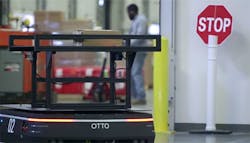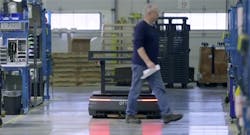There’s a new material handling crew at GE Healthcare’s 280,000-ft² Repair Operations Center in Milwaukee, Wisc., and they’re already having a huge impact on day-to-day operations. It’s a pair of OTTO Motors’ OTTO 1500 self-driving vehicles (SDVs), stocky, rugged mobile platforms that you never have to worry about getting lost or bumping in to you.
The plant handles more than 8,000 medical device repairs every month, and since being "hired" last April, the OTTO 1500 AMRs have seamlessly integrated into the workflow. Able to travel 4.5 mph and carry 3,300 lb., the independent movers are guided by an advanced OS inspired by Google’s self-driving car tech, along with a suite of sensors that ensure safe and efficient movement with no added infrastructure needed.
“What we really like about OTTO is it doesn’t need to be tied to something that is in the floor, like magnetic strips,” says Patricio Espinosa, GE Healthcare’s director of repair operations. “It can make the decision to turn and take different routes depending on where it needs to go. “
Photo: Otto Motors
In fact, the facility has reduced its repair cell station size by 40%, according to OTTO Motors.
This is due to OTTO taking on multiple roles for different applications, from delivering broken parts to repair cells and moving fixed devices to shipping zones. No matter the task, OTTO is always cognizant of its coworkers.
“Something we’re very proud of is that our OTTO software stack has been certified by some of our customer’s safety committees to operate on manned pathways within the plant,” says product director Simon Drexler.
Within the brightly lit confines GE Healthcare’s Milwaukee site, OTTO always gives the right of way to senior staff.
Photo: Otto Motors
“Occasionally we meet up with OTTO in the aisle ways and he works right around us, says,” says Joe Germait, a manufacturing technician at the plant.
OTTO, which typically provides an ROI in less than two years, also gives cues via its directional lights so workers can anticipate its next move.
“We always know what he’s doing and he’s aware of us being in the vicinity,” Germait says.
The key thing to notice here is that Germait uses the pronoun “he,” suggesting that the mobile robot is seen as one of the crew. This may be partly because the machine makes technicians jobs a little easier, or possibly because unlike a hulking six-axis arm that could splatter you against the wall, this benevolent little robot rolls along the factory floor like a less sassy R2D2.
Watch it in action:
And that non-threatening attitude is what will help OTTO, and other SDVs, ingratiate themselves to robot-wary workers, allowing them to assimilate more smoothly.
“They treat OTTO more like a person walking around their plant than they do a forklift or a tugger,” Drexler observes. “I can guarantee you that no safety committee is ever going to certify a forklift or tugger to operate on a manned path.”
OTTO Motors says because of the success, the plant plans on adding to the fleet soon.
About the Author
John Hitch
Editor, Fleet Maintenance
John Hitch, based out of Cleveland, Ohio, is the editor of Fleet Maintenance, a B2B magazine that addresses the service needs for all commercial vehicle makes and models (Classes 1-8), ranging from shop management strategies to the latest tools to enhance uptime.
He previously wrote about equipment and fleet operations and management for FleetOwner, and prior to that, manufacturing and advanced technology for IndustryWeek and New Equipment Digest. He is an award-winning journalist and former sonar technician aboard a nuclear-powered submarine where he served honorably aboard the fast-attack submarine USS Oklahoma City (SSN-723).



